By Linda Law
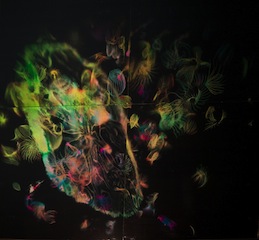 I write as someone whose adult life has (for the most part) been immersed in holography. It has been a grand passion. Walking into the International Center for Photography in 1975 for the show Holography '75: The First Decade July 3–September 19, 1975, and seeing my first hologram was a mind-blowing experience. I spent a long time looking at those images and walked out of ICP in a daze, utterly convinced that this was the medium I wanted to create images with.
I write as someone whose adult life has (for the most part) been immersed in holography. It has been a grand passion. Walking into the International Center for Photography in 1975 for the show Holography '75: The First Decade July 3–September 19, 1975, and seeing my first hologram was a mind-blowing experience. I spent a long time looking at those images and walked out of ICP in a daze, utterly convinced that this was the medium I wanted to create images with.
It has been a long journey, learning my craft, teaching about it, setting up facilities, working in Optical Research at New York Institute of Technology in tandem with the fabled Computer Graphics Lab in the early ‘80s, acting as curator of the New York Museum of Holography and curating independent shows of holograms, creating 3D animations for digital holograms, writing articles about holography and presently teaching it online and blogging about it.
Now, 38 years later I’ve been asked to write about the future of holography. I paused to think about this for a while. Despite the wobbly nature of 3D in the TV and cinematic worlds there are many developments and new approaches to a broad spectrum of 2D and 3D applications that people are calling holographic. It has put new life into a medium that is on a threshold of change in it’s own right but at the same time has caused much confusion.
Before I can talk about the future I think it is necessary to talk a bit about the past, as there is currently so much misinformation about holography. The medium was invented in the 1940s by Hungarian scientist Dr. Dennis Gabor who was at that time working in the UK. He coined the name hologram from the Greek words holo, meaning whole, and gram, meaning message: the whole message. The strict definition of a hologram is that it is a recording of an interference pattern of light into a photosensitive medium and a laser is required to do this. The technique could not be fully demonstrated until the first lasers were invented and in 1962 two scientists at the University of Michigan, Dr’s Emmet Leith and Juris Upatnieks, made the first holograms using lasers with very specialized optics and vibration isolation tables that prevented any movement during recording of the hologram.
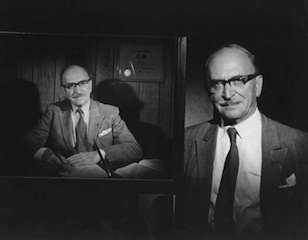 In the UK, just a few years later in 1968, pioneering artist, Margaret Benyon, taught herself how to do this and made her own art holograms at the University of Nottingham. This medium, which straddles the worlds of art and technology is challenging from many perspectives but offers so much potential to open up new realms of dimensional creative expression.
In the UK, just a few years later in 1968, pioneering artist, Margaret Benyon, taught herself how to do this and made her own art holograms at the University of Nottingham. This medium, which straddles the worlds of art and technology is challenging from many perspectives but offers so much potential to open up new realms of dimensional creative expression.
Over the next two decades we witnessed a very fertile period where artists and engineers collaborated in an exciting environment that kept shifting and changing as new techniques, lasers, chemistry and holographic emulsions were developed. Artists built their own labs, invented new ways to make these amazing images, and developed their own custom systems to illuminate and install them. We also formed a small global community that largely came together at conferences and to install holographic exhibitions. There were many shows, large and small, fine art shows in galleries and museums and also large shows in science museums that featured the varied applications of holography in art, science and technology.
Most of these analog holograms required the use of some form of real world object to create the hologram but one development, the Holographic Stereogram, was a precursor to the digital holographic techniques that are being developed today. Some of you may remember seeing cylindrical or semi-circular holograms that showed moving figures. A fairly widely seen example was a head and shoulder view of a woman blowing a kiss and then winking as you moved from left to right in front of the image. This was the work of a group in San Francisco led by holographer Lloyd Cross and these were commonly known as Multiplex holograms.
http://www.youtube.com/watch?feature=player_detailpage&v=Cz067kQ3W18
But this was pre-digital, made by shooting film with a pin registered 35mm film camera while the subject stood on a slowly rotating turntable. The processed film from this shoot was projected one frame at a time onto a long piece of holographic film about a foot high through an optical system that recorded these images as a series of vertical slit holograms. When you look at the final hologram your eyes see a sequence of stereo images that the hologram locates in the right position for each of your two eyes. You see a 3D image but it will change continuously as you move in front of it. By moving from side to side you can play it forwards or backwards, but you control the rate of movement.
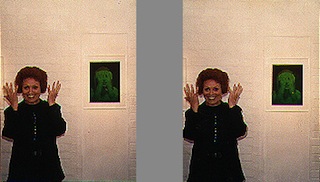 As we moved into the ‘90s it was apparent that our world was entering into a new digital phase and the analog aspect of early holography began a shift into the digital world. Over the past 20 years there have been a number of hybrid systems developed to create holograms from digital content. These holographic printers make it possible to create hard copy holograms from digital models rendered out to specific parameters for each particular system. These images can have some animation but it is limited to about 10 seconds. In addition, by using a digital video camera on a rail or an array of cameras firing simultaneously, it is also possible to make holograms from video content. Holograms produced this way can be quite large (so far up to about 2M x 2M) or as small as a ½” square label or a postage stamp. Depending on the type of hologram that is being printed and the company printing it, they can be either a one off (mostly the very large sized holograms) or millions of copies (small labels) with various sizes and copying volumes in between.
As we moved into the ‘90s it was apparent that our world was entering into a new digital phase and the analog aspect of early holography began a shift into the digital world. Over the past 20 years there have been a number of hybrid systems developed to create holograms from digital content. These holographic printers make it possible to create hard copy holograms from digital models rendered out to specific parameters for each particular system. These images can have some animation but it is limited to about 10 seconds. In addition, by using a digital video camera on a rail or an array of cameras firing simultaneously, it is also possible to make holograms from video content. Holograms produced this way can be quite large (so far up to about 2M x 2M) or as small as a ½” square label or a postage stamp. Depending on the type of hologram that is being printed and the company printing it, they can be either a one off (mostly the very large sized holograms) or millions of copies (small labels) with various sizes and copying volumes in between.
That holograms are essentially hard copy 3D images that go on the wall or sit on your desk may be a surprise to some of you. So many people were first exposed to the idea of holography in Star Wars with Princess Leia being projected out of R2D2 in her distress call and then later the idea of the Holodeck became firmly implanted in our minds by Star Trek.
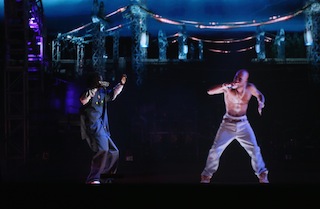 More recently rap artist Tupac Shakur was revived from the dead with a holographic performance at Coachella that set everyone talking about holograms again. None of these are holograms. None of these are even 3D. They are all a product of the imagination of Hollywood and musical promoters. These images have conditioned the world to think of holograms as a form of moving 3D without glasses and the public accepts these things as truth because they don’t know the difference, because, for the most part they’ve never seen a real hologram.
More recently rap artist Tupac Shakur was revived from the dead with a holographic performance at Coachella that set everyone talking about holograms again. None of these are holograms. None of these are even 3D. They are all a product of the imagination of Hollywood and musical promoters. These images have conditioned the world to think of holograms as a form of moving 3D without glasses and the public accepts these things as truth because they don’t know the difference, because, for the most part they’ve never seen a real hologram.
Speaking with Dr. Michael Bove at the Spatial Imaging Lab at MIT, (who inherited a pioneering project to make holo video from the late Dr. Stephen Benton, inventor of the Rainbow hologram), I learned that holographic video has taken a large step forward recently with a new low cost approach that they wrote about in a recent article in the journal, Nature. However, according to Michael, we are at least 10 years away (in practical terms) from a small sized commercial application of this technology. Even small sized, fully dimensional TV without glasses still has a way to go.
So, how do I see the future of holography?
Well, lately I’ve been looking at a number of projection techniques and dimensional systems that I think may be bridges towards the goal of fully dimensional moving holograms as well as some new developments in what might be called hard copy holograms.
Let’s look first at the Tupak Shakur “hologram.” This was produced by the use of an update of a very old technique (from Victorian times) that is known as Pepper’s Ghost. A technique used in theaters and by spiritualists of that time (and later by Disney in the Haunted House), it created illusions of ghosts using a large piece of glass and lighting the subject in a specific way. The image created with this technique appeared to be alive, moving, ghostly looking and seeming to hang in thin air.
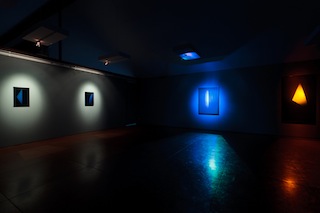 In the past few years this technique has been updated and the glass has been replaced by a thin Mylar film that is tightly stretched in huge sheets and is suspended across the stage of large theatres or even outdoors at a 45-degree angle.
In the past few years this technique has been updated and the glass has been replaced by a thin Mylar film that is tightly stretched in huge sheets and is suspended across the stage of large theatres or even outdoors at a 45-degree angle.
This alone did not make Tupak revive. It required shooting in very high resolution, some amazing CG work using a body double, and the mapping of Tupak’s head to the body as well as very powerful projectors that make the projected image look quite real. The fact that he moves around showing different parts of himself helps the illusion but it is still 2D.
There are several groups out there currently developing hybrid systems that take this technology a little further down the road towards what Star Trek fans would recognize as the Holodeck. Right now they are largely under wraps but I think that what we will see will be systems that look more and more convincing and that use higher definition projection and new ways of projecting stereo 3D, some without glasses. These may be quite effective and engaging and for all who have not seen an actual hologram, quite believable as holograms. I do think that with clever use of this medium many creative and engaging productions will be made.
Along side of this, virtual reality techniques in immersive media are a different hybrid approach, again not truly holographic but your brain receives input that makes you feel as though you are immersed in an interactive 3D world. These systems are becoming practical tools for engineers, designers, and artists to create art as well as prototypes of a wide range of products and to simulate testing them under a range of conditions. They are made more immersive by using haptic devices that simulate touch, navigation, and interactivity in those worlds.
Another approach that has been taken by a few companies is to create content that is rendered out as video from animated 3D computer models into many different camera views (say 20 or 30) or shot with that number of digital video cameras for a live situation and to project all of these views side by side onto a specially designed holographic screen. The screen creates a seemingly continuous viewing area from these many different perspective views and as you move from side to side in front of it you have the ability to look around within a moving 3D scene. Like a true hologram this device does not require glasses to view it.
Other groups are working with a variety of mechanical, scanning approaches to create volumetric images that appear 3D – again not truly holographic but interesting to explore. All of these approaches take us into worlds that are engaging and fun, although not really holographic, and as such can only go so far towards the true potential of what holograms can actually do.
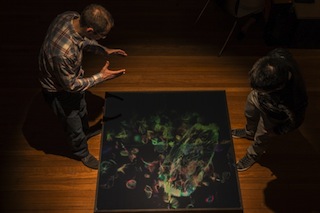 So, although we can’t yet make high enough quality moving true holographic images, we can make some pretty high quality digital holograms with around 200-1,000 frames of animation. It is now possible to create 3D animations, render them out to a particular spec for each custom system and send that data to a holographic printing facility where they will print a full color digital hologram. These are typically printed element by element or hogel by hogel (holographic pixel). There are a variety of these systems around the world, each producing a holographic image that has it’s own style or look depending on the material and chemistry used to record it on and process it (this part is still analog) and the design of the actual optical system. There is a growing small group of these commercial facilities spread out around the world. Artists such as the acclaimed Light and Space artist, James Turrell, and Pop Artist, Ron English, have made a number of holograms with these companies.
So, although we can’t yet make high enough quality moving true holographic images, we can make some pretty high quality digital holograms with around 200-1,000 frames of animation. It is now possible to create 3D animations, render them out to a particular spec for each custom system and send that data to a holographic printing facility where they will print a full color digital hologram. These are typically printed element by element or hogel by hogel (holographic pixel). There are a variety of these systems around the world, each producing a holographic image that has it’s own style or look depending on the material and chemistry used to record it on and process it (this part is still analog) and the design of the actual optical system. There is a growing small group of these commercial facilities spread out around the world. Artists such as the acclaimed Light and Space artist, James Turrell, and Pop Artist, Ron English, have made a number of holograms with these companies.
New developments in recording materials coupled with a new generation of diode lasers (tiny, more powerful and cheaper) and three wavelength pulsed laser systems (which make ultra short bursts of intense laser light) have made some advances possible in analogue holography that are very significant. We now have panchromatic holographic emulsions (they record a full spectrum of visible light wavelengths). Some of these record laser light into the older silver halide type emulsions that require chemical processing and others record laser light into a photopolymer that is essentially “fixed” by either baking it or flashing it with UV light – no chemical processing. These new materials have been used to make holograms of real world objects that are so convincing that it is nearly impossible to tell which is the real hologram and which is the object when displayed similarly.
Holographic artists are also pushing the envelope with digital holographic technology. Dr. Paula Dawson who teaches at the University of New South Wales in Australia is a pioneering holographic artist who followed in the footsteps of Margaret Benyon and over the years has created a startling array of holographic art that has always been at the edge of the newest technology. Most recently she has been working with a haptic device known as the Phantom.
Thinking about holography in the near future I strongly believe that we are moving towards a next generation of holographic images that will be startling in their realism. With that level of quality holograms will be open for exploration in a multitude of abstracted and imaginative ways. Of course, the success of such holograms depends even more on the skills of the artists creating the content because ultimately content is the ingredient in this mix and writing on the subject of creativity in content brings me back to my own work in this field.
I have been convinced for a long time that it is essential for any artist who wants to create content for digital holograms using 3D animation to also learn as much as possible about analog holography. Analog holograms have unique properties that do not exist in any other medium.
To give you a taste, each little piece of the holographic image contains information about the whole image; you can create interpenetrating dimensions; you can encapsulate time and space and then play it backwards and forwards as you interact with the image. When you understand the subtleties of the many techniques of analog holography you can begin to get your head around how to create 3D animations within the computer that can simulate these phenomena. Then you have the potential to create truly effective holograms from digital content. Without this you will just be making a hard copy form of 3D animation created on a 2D screen.
So, here and now, I feel like we are poised on the threshold of a new wave of holographic possibilities. Just today I read a report from Matt Brennesholtz at Display Central who wrote about the decline in box office for S3D but he also reports that Markets and Markets Analysis predict that the global 3D imaging market is expected to grow from $3.01 billion in 2013 to $9.82 billion by 2018. The market he identifies embraces all of the imaging techniques that this article has discussed. A door is opening into a dimensional imaging world that is pregnant with creative potential and waiting for inspired artists to explore it.
Linda Law is a digital/holographic artist/educator who is currently offering online courses in how to create content for digital holograms. You can read more about holography and her work on her blog at www.artinthe5thdimension.com, you can view her profile on LinkedIn, and she can be contacted at [email protected].
